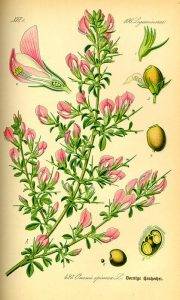
Spiny iglice – Ononis spinosa L.
Description of thorny iglice:
Ononis spinosa (Old or other familiar names: plough-barrier, plough-grass, plough-grass, gorse-grass, gilice-thorn, gilice-thorn, gorse-thorn, gorse-thorn, gorse-thorned igric) Leguminosae – Leguminosae The thorny iglice is a perennial, semi-shrubby plant. Its dark brown or black roots are 50-60 cm long and 1-2 cm thick, penetrating deep into the ground, twisting in a curve, twisted, woody, very hardy. It prefers lime in the soil, and where it is found, it is a sign that the soil contains lime. Where there is no trace of lime in the subsoil, the iglice will not grow. Stems are erect, 60 cm high, rounded, woody above and woody below. It has one or two rows of shaggy, slightly glandular hairs along its length. Sides terminate in prickly spines; sparsely inbred. Lower leaves trifoliate, upper ones, especially around flowers and on lateral branches, undivided, clustered on short lateral branches. The individual leaflets are oblong-ovate, slightly pointed, with intact margins at the base and serrate teeth at the tip. The leaf base has a broad, ovate palea. Flowers pink, in the axils of the short lateral branches, mostly solitary, rarely in twos. Their throats are very short. The thorny iglice blooms in June and July, in more northerly areas from July to the end of August.
Occurrence:
The thorny iglice is found on pastures and heaths in the central and western parts of the country, but it does not occur in the eastern part of the country, where it is replaced by other iglice species.
The medicinal properties and uses of thorny iglice:
The thorny iglice has an unpleasant smell when fresh, which it loses after drying. Where it proliferates, it becomes an unpleasant weed that is difficult to eradicate. Its deep roots hold up the plough, hence the name ploughsoil and plough gully. And its prickly thorns can wound a field hand. Its woody roots are dug up, dried and used as a blood purifier and diuretic. It is known in the trade as radix ononidis spinosae. It is mainly used in veterinary medicine and is also mixed with a blood-purifying pate, tasting scratchy, slightly bitter and sweet at the same time; its smell is slightly reminiscent of liquorice.
Consumption:
The root of thorny iglice should be dug up in late autumn or early spring. The root is cut out of the ground with a pick or a stone cutter, then cleaned of soil and sand, and the thicker roots are cut lengthwise several times to dry them. It is better to dig up the roots of perennial plants because they are thicker. Iglice is mentioned in the official pharmacopoeia, our pharmacies keep it in stock, but demand is not high, there is no export of it. Source: Béla Páter, The wild herbs
